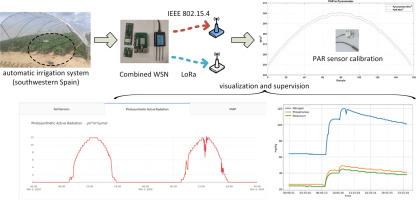Efficient irrigation system using a combined wireless sensor network based on LoRaWAN and IEEE 802.15.4 technologies and photosynthetically active radiation measurements
IF 7.6
3区 计算机科学
Q1 COMPUTER SCIENCE, INFORMATION SYSTEMS
引用次数: 0
Abstract
To address the demands of wireless communication, small amount of transmission, low power consumption, and cost-effectiveness in agricultural Internet of Things (IoT) applications, this paper introduces a hybrid information monitoring approach. It combines a low-data-rate personal area network based on IEEE 802.15.4 with a low-power wide-area network utilizing LoRaWAN. This method employs a communication architecture comprising a central node, multiple subnodes, and end devices to support the needs of large-scale information monitoring. Specifically, the main node is designed using LoRaWAN communication technology and performs in-field measurements of photosynthetically active radiation (PAR) using a device calibrated through intercomparison with reference radiometers. The subnodes or cluster heads incorporate LoRaWAN, sensor technologies, and IEEE 802.15.4. End devices also utilize IEEE 802.15.4 and sensor technologies. A control terminal manages sensor data and transmits the collected information to a web application for further processing. The advantages of this approach are that combining IEEE 802.15.4 and LoRaWAN at the device level enhances the spatial variability of agricultural fields, since tree and star network topologies are integrated to collect detailed information about specific crop areas, while providing low-power, long-distance network services and reducing the operating costs of the wide-area network information monitoring system. Additionally, hardware and firmware strategies were applied to further extend the system autonomy, and it can be self-powered. System testing revealed that, in a challenging environment, the maximum communication range reaches up to 60 m for IEEE 802.15.4 and 2 km for LoRaWAN. The average energy consumption is only 0.55 mAh, supporting real-time monitoring with latency under 100 ms, and the packet loss rate is approximately 2.5 %. Overall, the system operates reliably, and the data collected are accurate. The findings indicate that the proposed method effectively fulfills the needs for data gathering, transmission, storage, and processing across large areas. Furthermore, it proves to be valuable for implementing strategies aimed at improving both irrigation systems and the cultivation process of strawberry crops.

利用基于LoRaWAN和IEEE 802.15.4技术的组合无线传感器网络和光合有效辐射测量的高效灌溉系统
针对农业物联网应用中无线通信、传输量小、功耗低、性价比高等要求,提出了一种混合信息监控方法。它结合了基于IEEE 802.15.4的低数据速率个人局域网和利用LoRaWAN的低功耗广域网。该方法采用由一个中心节点、多个子节点和终端设备组成的通信体系结构,以支持大规模信息监控的需求。具体来说,主节点采用LoRaWAN通信技术设计,并使用通过与参考辐射计相互比较校准的设备进行光合有效辐射(PAR)的现场测量。子节点或簇头结合了LoRaWAN、传感器技术和IEEE 802.15.4。终端设备还使用IEEE 802.15.4和传感器技术。控制终端对传感器数据进行管理,并将采集到的信息发送给web应用程序进行进一步处理。该方法的优点是在设备层面将IEEE 802.15.4和LoRaWAN相结合,增强了农田的空间变异性,因为树形和星形网络拓扑相结合,可以收集特定作物区域的详细信息,同时提供低功耗、长距离的网络服务,降低了广域网信息监控系统的运行成本。此外,硬件和固件策略被应用于进一步扩展系统的自主性,它可以自供电。系统测试表明,在具有挑战性的环境下,IEEE 802.15.4的最大通信距离可达60米,LoRaWAN的最大通信距离可达2公里。平均功耗仅为0.55 mAh,支持100ms以下的实时监控,丢包率约为2.5%。总体而言,系统运行可靠,采集数据准确。研究结果表明,该方法有效地满足了大范围数据采集、传输、存储和处理的需求。此外,它被证明对实施旨在改善灌溉系统和草莓作物栽培过程的战略是有价值的。
本文章由计算机程序翻译,如有差异,请以英文原文为准。
求助全文
约1分钟内获得全文
求助全文
来源期刊

Internet of Things
Multiple-
CiteScore
3.60
自引率
5.10%
发文量
115
审稿时长
37 days
期刊介绍:
Internet of Things; Engineering Cyber Physical Human Systems is a comprehensive journal encouraging cross collaboration between researchers, engineers and practitioners in the field of IoT & Cyber Physical Human Systems. The journal offers a unique platform to exchange scientific information on the entire breadth of technology, science, and societal applications of the IoT.
The journal will place a high priority on timely publication, and provide a home for high quality.
Furthermore, IOT is interested in publishing topical Special Issues on any aspect of IOT.
 求助内容:
求助内容: 应助结果提醒方式:
应助结果提醒方式:


